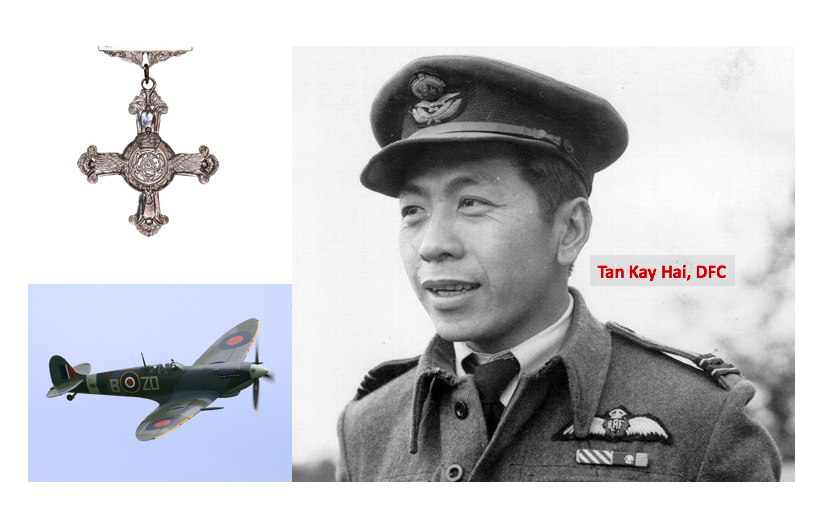Most of us will probably think of the likes of Lim Bo Seng, Adnan Saidi, and Elizabeth Choy when we're asked to name some Singaporean war heroes from World War Two.
Their stories of bravery are after all well publicised, and often told and re-told (and rightfully so too).
But beyond these notable figures in our history, there are others whose war stories are no less compelling.
One lesser known story is that of a Singaporean man named Tan Kay Hai, whose military exploits as a British Royal Air Force (RAF) pilot in Europe during the Second World War is worthy of being made into a Hollywood movie.
[caption id="" align="aligncenter" width="600"] Tan Kay Hai. Image via WWII British Empire & Commonwealth Forces in the Far East-SE Asia 1937-1946 Facebook.[/caption]
Tan Kay Hai. Image via WWII British Empire & Commonwealth Forces in the Far East-SE Asia 1937-1946 Facebook.[/caption]
His is a story that needs to be told.
First local Chinese man to be accepted into RAF training
Born on March 10, 1914, Tan was the first local Chinese man and also the first married man to join the RAF's Training School in Singapore in August 1941, with World War Two in progress in China and Europe, where Britain was fighting Germany alone.
At 26, he was considerably older than his peers in the intake.
An alumnus of St Andrew's School, Tan, who hailed from a wealthy family, had been working at Malayan Motors as a salesman before joining the RAF.
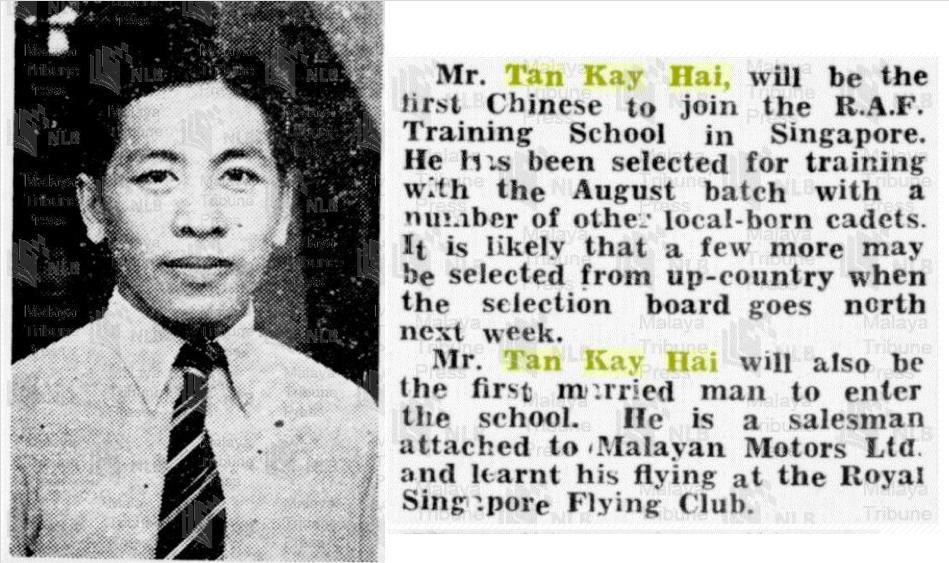 Sunday Tribune (Singapore), June 15, 1941. Source: NewspaperSG
Sunday Tribune (Singapore), June 15, 1941. Source: NewspaperSG
Some prior flying experience gave him a leg up though.
According to researcher Ernest Koh's paper entitled The Chinese of Singapore and their imperial Second World War
1939 – 1945, Tan, who was a member of the Royal Singapore Flying Club, had learnt to fly the single-engine de Havilland Tiger Moth, which was a biplane used by the RAF at the time.
[caption id="" align="aligncenter" width="1024"] de Havilland Tiger Moth biplane. Source: Wikipedia[/caption]
de Havilland Tiger Moth biplane. Source: Wikipedia[/caption]
Further training in Canada and England
After completing his initial training in October 1941, he was sent to Canada for further training.
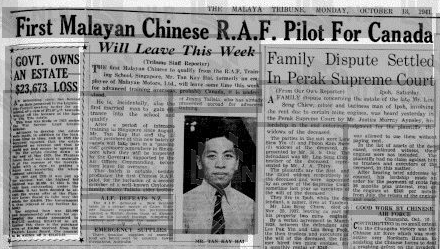 Malaya Tribune on Oct. 13, 1941. Source: NewspaperSG
Malaya Tribune on Oct. 13, 1941. Source: NewspaperSG
He was commissioned as a Pilot Officer and transferred to England at the end of January 1942, where he underwent advanced training.
Singapore would fall to the Japanese around this period on Feb. 15, 1942, and Tan's hopes to serve in Singapore were dashed.
Flying combat missions in North Africa
Nonetheless, by April 1943, "Charlie Chan", as he had come to be known to his colleagues, was sent to Tunisia in North Africa to fly his first combat missions in the British-made Spitfire.
The Spitfire was an iconic and powerful fighter plane in the war often credited with helping the British win the Battle of Britain air war against the Germans in 1940.
Note: Some accounts on Tan inaccurately claim that he fought in the Battle of Britain. When Tan began training with the RAF in 1941, the Battle of Britain was already over.
[caption id="" align="aligncenter" width="1024"]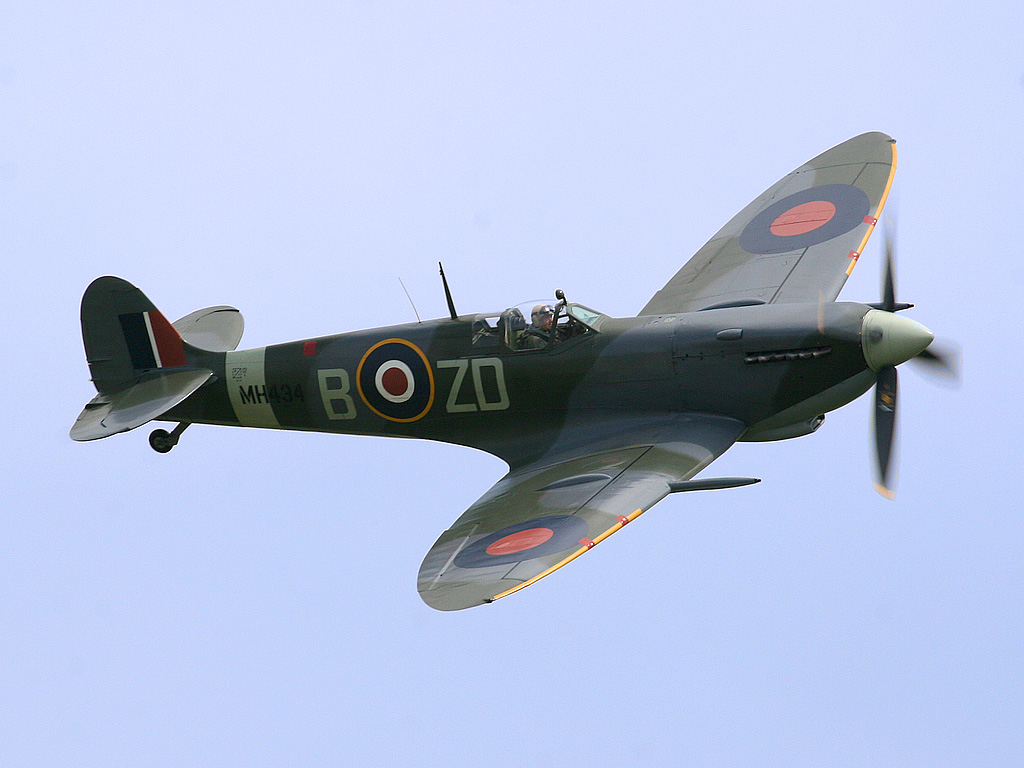 A Supermarine Spitfire. Source: Wikipedia[/caption]
A Supermarine Spitfire. Source: Wikipedia[/caption]
Tan flew combat reconnaissance sorties to locate enemy artillery and observe the effect of Allied strikes on them.
Following the surrender of the German forces in North Africa, however, Tan was sent to support the Allies' campaign in Italy, where his sorties became more dangerous.
[related_story]
Awarded the Distinguished Flying Cross while in Italy
Flying tactical reconnaissance missions in Italy, Tan had to put himself at great risk by flying at low altitudes to entice enemy anti-aircraft gunners to fire at his plane, which in turn would give away their respective positions.
Knowledge of these positions served as valuable intelligence for military planners.
But Tan went a step further on his missions. He would attack and silence enemy positions after they had revealed themselves.
His cavalier and aggressive exploits earned him the Distinguished Flying Cross (DFC) -- a prestigious military honour -- during his time in Italy. He was the first Straits Chinese to be awarded the DFC.
[caption id="" align="aligncenter" width="244"] DFC. Source: Wikipedia[/caption]
DFC. Source: Wikipedia[/caption]
Tan's commanders' recommendation for his DFC read as follows:
"On February 7th 1944, F/O (Flight Officer) Tan set out on a combined vertical photographic and visual reconnaissance in the LITTORIA-CORI area. They arrived during a bombing attack on the beach-head, and 20+ bandits were reported. F/O Tan and his weaver were intercepted by 5. 190’s (German fighters), and they became separated.
On his own, in the face of intense A.A. (anti-aircraft) fire, and knowing that bandits were in the vicinity, F/O Tan successfully completed his mission. In addition to the five pinpoints which he had been briefed to photograph, he photographed two artillery positions, which he pinpointed South of Rome.
One on the following day, he was briefed to do an artillery shoot in the AUSONIA area. He was given the positions of five enemy batteries, and was told to engage three. Nevertheless, he successfully engaged all five of these, then registered a further battery which he had located, and finally successfully engaged a concentration of enemy H.T. (Half-Track transports)
This Officer has now completed 146 hours operational flying with this Squadron, having joined 225 in April 1943. Since then he has served with distinction in N. Africa, Sicily, and Italy. His exceptional keenness, initiative and total disregard of danger, have been an inspiration to his fellow pilots, and the above two examples of his work are in keeping with the high standard he has set during the last few months."
After the war, The Straits Times ran this report on Tan:
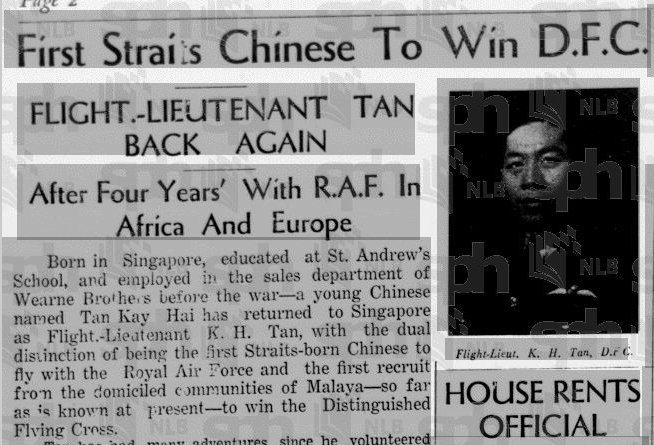 ST on Sep. 18, 1945. Source: NewspaperSG
ST on Sep. 18, 1945. Source: NewspaperSG
But wait... that's not it, his adventures did not end with his DFC. There's more to Tan's amazing story.
Only S'porean to have flown on D-Day
In May 1944, Tan's Italian campaign ended when he was transferred to England to prepare for and support what is still today considered the largest amphibious military operation in history -- the D-Day landings in Normandy, France.
D-Day on June 6, 1944 was a critical turning point in world history, when the Allies managed to successfully land their forces in occupied France and commence with the liberation of Nazi-occupied Europe.
It paved the way to the end of the Second World War in Europe, but it would take about another year of fighting on the continent before Germany surrendered.
Meanwhile, in the lead-up to D-Day, Tan was trained to fly yet another powerful and iconic fighter -- the US-made P-51 Mustang -- which was a new airplane that had entered service during the war.
The P-51, with its long operational range, played a major role in helping the Allies dominate the skies over Europe near the end of the war.
[caption id="" align="aligncenter" width="1920"]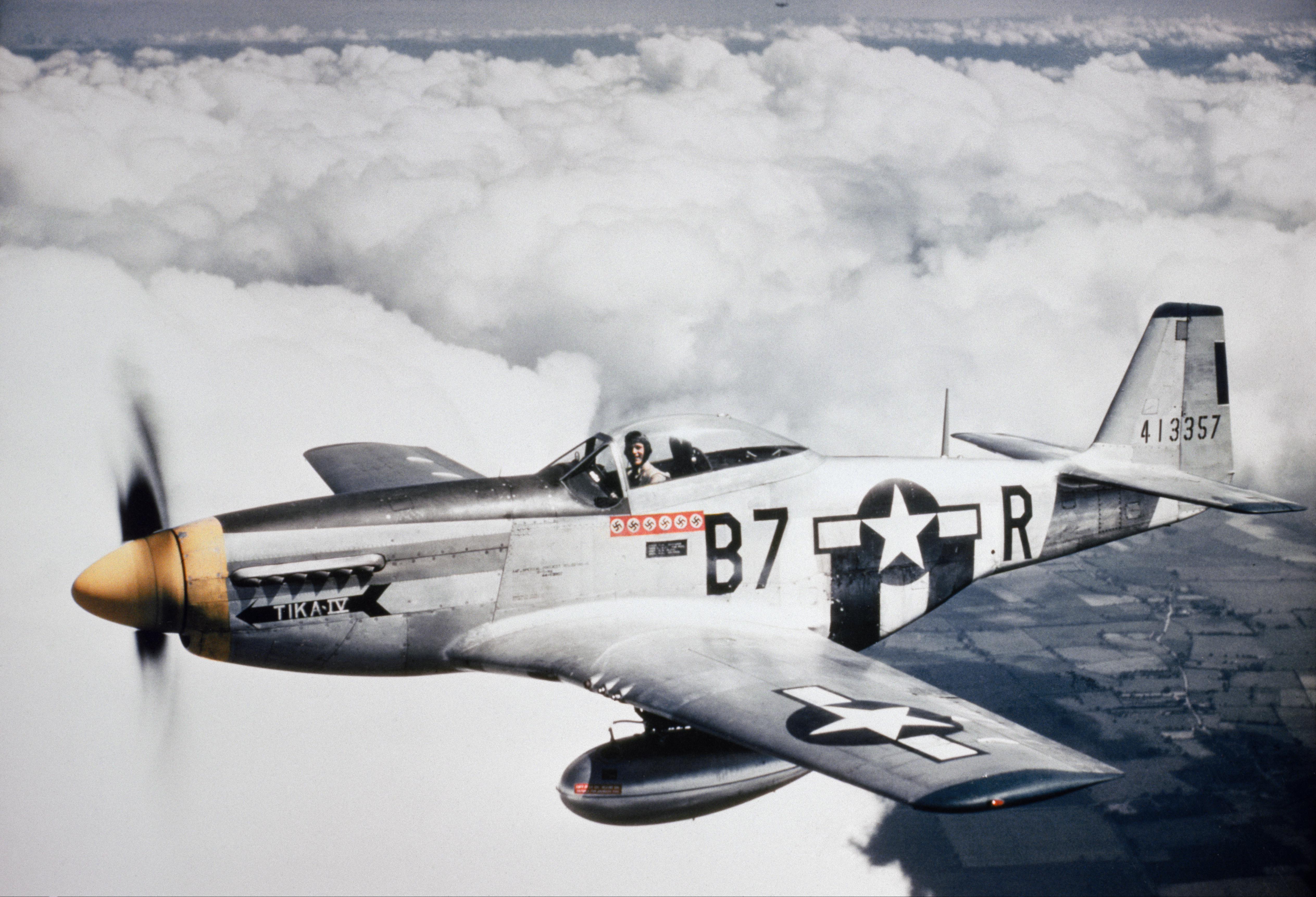 P-51 Mustang. Source: Wikipedia[/caption]
P-51 Mustang. Source: Wikipedia[/caption]
Tan flew aerial reconnaissance missions over France on D-Day (June 6, 1944), becoming the only Singaporean pilot to have been involved in the operations.
One of his missions involved the aerial spotting of enemy targets for naval bombardment in the morning over the section of beach along the Normandy coast codenamed "Sword Beach", where British troops were storming ashore.
[caption id="" align="aligncenter" width="668"] British troops storming Sword Beach on D-Day. Source: Wikipedia[/caption]
British troops storming Sword Beach on D-Day. Source: Wikipedia[/caption]
Continuing with his daring flying, Tan also attacked German ground forces at every opportunity over France.
Shot down over France
Up till that point, Tan would sometimes sustain damage to his plane on his missions. Fortunately, none were serious enough to take his plane down.
But this lucky streak of his ended on June 29, 1944.
While on the return leg of a reconnaissance mission near Paris, Tan, who was flying as wingman among two planes at low altitude, encountered eight German fighters approaching from behind.
Four of them went after Tan.
Seemingly unfazed by the overwhelming odds, Koh noted that Tan turned his plane around to face the Germans.
It was display of aggression by Tan, as the manoeuvre would have tactically set him up to engage the oncoming enemy fighters in an aerial dogfight, allowing him to fire his guns at them head-on and dispersing their formation in the process.
Unfortunately, however, his right wing was hit badly by canon fire from one of the German fighters during the turn. This sent his aircraft into a terminal spin at low altitude.
Barely managing to exit his falling aircraft at just a few hundred feet in the air, Tan managed to successfully deploy his parachute, but it did not quite fit around his small frame. He hit the ground hard while hanging face-down from his harness.
Having survived the rough fall, he somehow managed to collect his senses, bundle his parachute up under an arm, and stagger to nearby farmhouses for help, despite having three broken ribs, one broken arm, and a dislocated shoulder.
A young couple at the second farmhouse he knocked on rendered him some assistance, after he was turned away at the first house he approached. They provided him with a change of clothes and let him sleep in a shed.
Captured by the Germans
Unfortunately, however, Tan suspected they were also the ones who had reported him to the Germans using his uniform as evidence.
He was arrested by the German SS a few days later and sent to the Stalag Luft III prisoner-of-war camp (POW) camp located in Lower Silesia, near the Polish-German border.
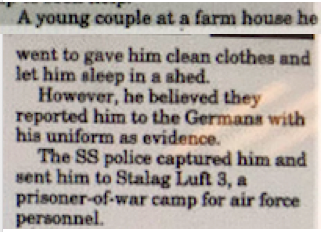 TNP on Jun. 5, 2004. Source: NewspaperSG
TNP on Jun. 5, 2004. Source: NewspaperSG
Incidentally, before Tan was sent to Stalag Luft III, the POW camp for Allied airmen was the setting of the famous Great Escape in March 1944, when Allied POWs audaciously attempted to escape through tunnels they had dug over the months before.
The event has been made into the famous movie called The Great Escape.
[caption id="" align="aligncenter" width="633"] A Model of Stalag Luft III. Source: Wikipedia[/caption]
A Model of Stalag Luft III. Source: Wikipedia[/caption]
It seems possible that Tan might have met some of the Allied prisoners involved in the audacious escape attempt months before.
The camp's security would have been tightened after the incident.
But Tan's war story was not over yet, despite his capture by the Germans.
Escaped from German captivity
His time as a POW did not last long.
In Jan. 1945, the Germans evacuated Stalag Luft III in the face of advancing Soviet troops, and the POWs were transferred to another location.
According to Tan's family's accounts quoted in The New Paper on Jun. 5, 2004, he made his own audacious escape during the transfer by jumping off a train.
He then had to forage for food in the forests for three days, before he was rescued by U.S. troops.
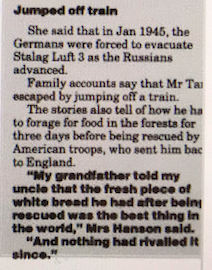 TNP on Jun. 5, 2004. Source: NewspaperSG
TNP on Jun. 5, 2004. Source: NewspaperSG
Tan was sent back to England and was flying training missions with the RAF again by mid-May 1945.
With Victory in Europe Day over the Germans declared on May 8, 1945, Tan was set to be transferred to the Pacific theatre to fight the Japanese.
However, Japan would surrender before he was posted to his next squadron.
Tan flew at least 190 missions throughout the war.
After the war
Following the war, Tan took a course in social work at the London School of Economics and did pretty well in it too, obtaining first class places.
 ST on Aug. 28, 1947. Source: NewspaperSG
ST on Aug. 28, 1947. Source: NewspaperSG
Back in Singapore, he was instrumental in the setting up of the Malayan Auxiliary Air Force (MAAF) -- the forerunner of Malaysia and Singapore's present day air forces -- and was appointed Wing Commander to train new local pilots.
He would also work in the Social Survey Department.
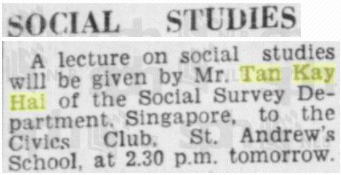 Singapore Free Press on Aug. 17, 1948. Source: NewspaperSG
Singapore Free Press on Aug. 17, 1948. Source: NewspaperSG
With the disbandment of the MAAF in 1960, Tan's flying career came to an end, and according to a Straits Times report on Nov. 2, 1991, he worked in the Department of Social Welfare until he retired.
 ST on Nov. 2, 1991. Source: NewspaperSG
ST on Nov. 2, 1991. Source: NewspaperSG
Throughout his life after the war, Tan had a mysterious bullet embedded in his big toe. No one knew how he got it because he seldom spoke of his experiences or told his full account of his military exploits to anyone.
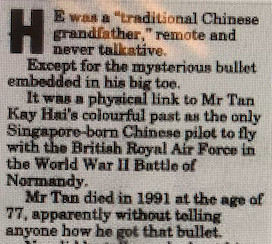 TNP on June 5, 2004. Source: NewspaperSG
TNP on June 5, 2004. Source: NewspaperSG
He feared that talking about his experiences might seem like he was bragging.
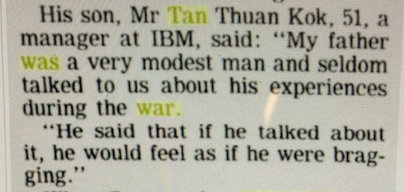 ST on Nov. 2, 1991. Source: NewspaperSG
ST on Nov. 2, 1991. Source: NewspaperSG
Tan passed away in 1991 at the age of 77. He is buried at Kranji War Cemetery.
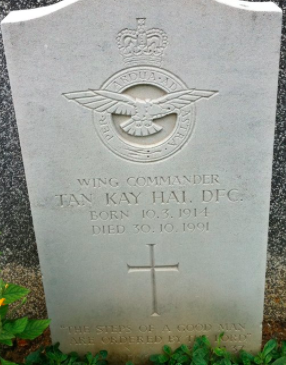 Image by David58 via billiongraves.com
Image by David58 via billiongraves.com
Here are other interesting articles to check out next:
Have grand plans of retiring on a farm? We tried it for you. Kinda.
Noob learns to code for three hours, tries to replicate Mothership as fake news site
These stories of Singaporeans rallying to help each other will make you have faith in humanity again
Quiz: What kind of Chinese New Year gift are you?
Random trivia about Changi Airport you never needed to know
Top image adapted from Wikipedia and WWII British Empire & Commonwealth Forces in the Far East-SE Asia 1937-1946 Facebook.
If you like what you read, follow us on Facebook, Instagram, Twitter and Telegram to get the latest updates.
